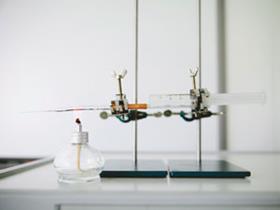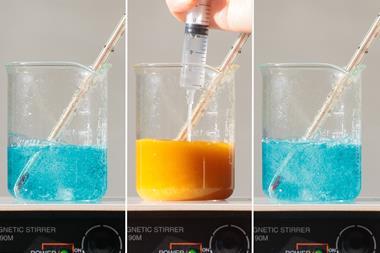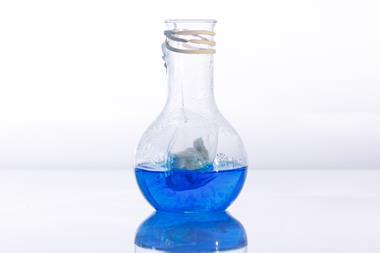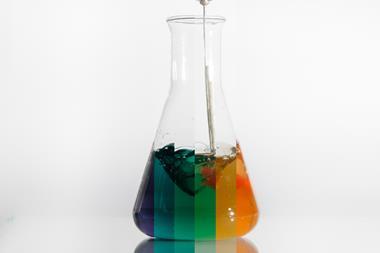The reduction of copper oxide is one of the most common practicals used when introducing redox reactions and their applications in the extraction of metals. Often this will involve students heating copper oxide in a boiling tube or crucible in the presence of carbon powder. The result is often underwhelming and students can fail to see the colour of any copper they produce among the carbon.
A more reliable demonstration uses hydrogen as the reducing agent: it does not mask the colour of the copper that is produced and it has the additional advantage that the oxidation product is visible as condensation. However, the large scale version of this demonstration has a reputation for causing explosions when hydrogen/air mixtures form inside the tube. The following is a description of a smaller scale demonstration adapted by Bob Worley at CLEAPSS from one developed by Bruce Mattson at Creighton University, US. It works just as well and is far safer.
The glow of the reaction and the condensation are easily seen. The students are able to observe the formation of copper (it often creates an attractive mirror on the glass) and the safer demonstration means you can free up more of your mind to communicate with the class.
Kit
- 50 cm3 plastic syringe
- Silicone tubing
- Glass Pasteur pipette
- Spirit burner containing ethanol
- Microspatula
- 0.1 g copper(II) oxide (hazardous to the environment)
- Borosilicate test tube
Preparation
Heat the copper oxide in a test tube to drive off any moisture. Allow it to cool. Fill the syringe with hydrogen from a cylinder or chemical generator. A Luer-Lock fitting or small piece of Blu-Tack can be used to seal the syringe so that the gas can be collected in advance of the lesson.
Set up the apparatus as shown and place a microspatula of copper(II) oxide (approximately 0.1 g) in the pipette. Ensure the pipette is not blocked by the solid.

In front of the audience
Light the spirit burner (do not use a hotter flame as this will melt the pipette). Heat the powder for two minutes before pushing the syringe barrel home. The powder will incandesce as the hydrogen reduces the copper(ii) oxide and droplets of water will appear near the open end of the pipette.
Once the apparatus has cooled, you can take it apart and pass the Pasteur pipette around for students to examine.
Alternative methods
A variation of this method can be used to reduce other oxides as well, including lead(II) oxide, iron(III) oxide and cobalt(II) oxide. The products of the latter two are magnetic. In these cases the reaction is not visibly exothermic.
An alternative apparatus suggested by CLEAPSS uses an in situ hydrogen generator in the form of a vial containing zinc and 2M hydrochloric acid.1 This usually forms a beautiful copper mirror.
Teaching goal
This demonstration would lend itself to any topics involving redox or metal extraction. Students should be invited to consider the relevance of the condensation appearing in the pipette.
Acknowledgements
Support for this demonstration was supplied by Bob Worley at CLEAPSS, who wrote an article on microscale chemistry back in May 2012.2
Safety
- Wear eye protection.
- The small space inside the pipette reduces the volume of any potential fuel-air mixture inside and the possibility of injury should it ignite.
- Light the spirit burner only after you have collected the hydrogen in the syringe.
- Ensure the apparatus is cool before attempting to disconnect the pipette.
References
- Safer chemicals, safer reactions (Guide L195). CLEAPSS, July 2006
- Education in Chemistry, May 2012, p19















![Feature microscale pg022 fig5 250 tcm18 216607[1]](https://d1ymz67w5raq8g.cloudfront.net/Pictures/100x67/9/4/2/113942_feature_microscale_pg022fig5_250_tcm182166071_353125.jpg)




No comments yet